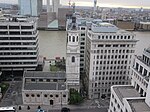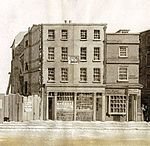Pudding Lane

Pudding Lane is a small street in London, widely known as the location of Thomas Farriner's bakery, where the Great Fire of London started in 1666. It runs between Eastcheap and Thames Street in the historic City of London, and intersects Monument Street, the site of Christopher Wren's Monument to the Great Fire. Farriner's bakery stood immediately opposite the Monument, on the eastern side of Pudding Lane. The site was paved over when Monument Street was built in 1886–7, but is marked by a plaque on the wall of nearby Farynors House, placed there by the Bakers' Company in 1986.Pudding Lane was given its name by the butchers of Eastcheap Market, who used it to transport "pudding" or offal down to the river to be taken away by waste barges. There was a wharf at its lower end called Rothersgate (from the "rothers" or cattle that were landed there), and it was also known as Rother Lane. Another name for it was Red Rose Lane, from a shop sign that once hung in it.Pudding Lane was one of the world's first one-way streets. An order restricting cart traffic to one-way travel on Pudding Lane and 16 other lanes around Thames Street was issued in 1617, an idea not copied until Albemarle Street became a one-way street in 1800. The nearest Underground station to Pudding Lane is Monument, a short distance to the west. The closest main-line railway stations are Fenchurch Street and Cannon Street.
Excerpt from the Wikipedia article Pudding Lane (License: CC BY-SA 3.0, Authors, Images).Pudding Lane
Pudding Lane, City of London
Geographical coordinates (GPS) Address Nearby Places Show on map
Geographical coordinates (GPS)
| Latitude | Longitude |
|---|---|
| N 51.5102 ° | E -0.0853 ° |
Address
NatWest
Pudding Lane
EC3R 8AB City of London
England, United Kingdom
Open on Google Maps











